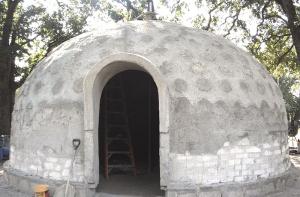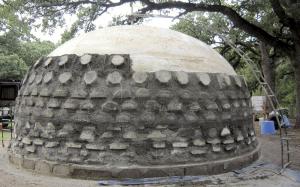2010 - Volume #34, Issue #6, Page #42
[ Sample Stories From This Issue | List of All Stories In This Issue | Print this story
| Read this issue]
New Way To Put Up A "Dome"
 |
 |
 |
The larger the dome, the thicker the walls need to be to support the roof. "I started the one in the photos with blocks 10 in. thick, which turned out to be way more strength than was needed," explains Pennington. "I switched partway up to a 6-in. thick wall, which was more than enough."
Before starting the dome itself, he laid down a base ring to which the inflated "balloon" form could be attached. At around $5,000, it was the most expensive component in the entire process.
Once the air form was inflated, block was laid against it and mortared together. "It took about 4 hrs. after we finished before the partially finished dome walls are strong enough to stand on their own without the form," says Pennington. "The mix cures pretty quickly, even in the rain."
Pennington uses shredded paper with polystyrene beads and cement for his "structural mix". The polystyrene and paper provides 80 percent of the bulk and produces a material that is water resistant, fire proof, and can be pounded with a hammer. It holds screws and nails like wood without cracking. Like the blocks he uses, it's light.
"Concrete runs around 140 lbs. per cu. ft. depending on the mix," says Pennington. "My structural mix is about 35 lbs. per cu. ft."
After the first course of blocks is laid, he installs a door form, which he then works around as he lays up additional blocks. The form was specially designed to fit the curvature of the dome.
"You can install forms for doors and windows as you go or simply cut them out as needed after the dome is up," explains Pennington.
One of the keys to fast dome work is his unique scaffold. Working up and over the developing dome requires a freestanding support for the person laying the block, especially as the walls curve over the top half of the dome.
"I needed a scaffold that could be moved around to access the entire dome," explains Pennington.
The key to the scaffold is a pipe that comes up the center through a hole in the balloon form. A curved ladder attaches to the top of the center point and extends down to the ground. The ladder pivots freely around the outside of the dome.
Once he was finished, Pennington had a 20-ft. dia. dome with a 315 sq. ft. base. With its door and eventually windows, this dome will serve as a small cabin. It could be equally useful as a storage building or workshop.
Pennington is confident his dome success can be repeated. He plans to begin producing lightweight blocks for people interested in building a dome themselves. He will produce the blocks, the air form, scaffold ladder, mortar mix and expertise. With a base ring in place and four helpers on site, he says a 20-ft. dome can be constructed in a day.
"You would have a high-performance building for around $10 per sq. ft.," he says. "Multiple domes can be connected to form a larger building."
Contact: FARM SHOW Followup, Dave Pennington, 203 Pauline Dr., Richardson, Texas 75081 (ph 972 680-1982; cell 214 235-5839; aquaponicdave@gmail.com; www.papercretedomes.com).

Click here to download page story appeared in.

Click here to read entire issue
To read the rest of this story, download this issue below or click here to register with your account number.




